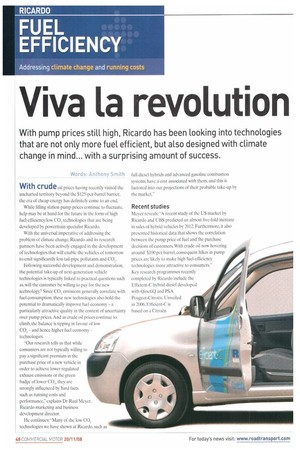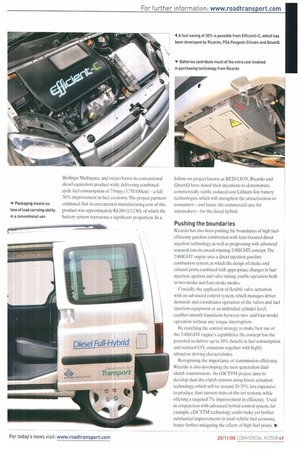Viva la revolution
Page 48

Page 49

If you've noticed an error in this article please click here to report it so we can fix it.
With pump prices still high, Ricardo has been looking into technologies that are not only more fuel efficient, but also designed with climate change in mind.., with a surprising amount of success.
Words: Anthony Smith
With crude oil prices having recently visited the uncharted territory beyond the $125-per-barrel barrier, the era of cheap energy has definitely come to an end.
While filling station pump prices continue to fluctuate. help may be at hand for the future in the form of high fuel-efficiency/low CO, technologies that are being developed by powertrain specialist Ricardo.
With the universal imperative of addressing the problem of climate change. Ricardo and its research partners have been actively engaged in the development of technologies that will enable the vehicles of tomorrow to emit significantly less tail-pipe pollutants and CO,.
Following successful development and demonstration, the potential take-up of next-generation vehicle technologies is typically linked to practical questions such as, will the customer be willing to pay for the new technology? Since CO2 emissions generally correlate with fuel consumption, these new technologies also hold the potential to dramatically improve fuel economy — a particularly attractive quality in the context of uncertainty over pump prices. And as crude oil prices continue to climb, the balance is tipping in favour of tow
CO, — and hence higher fuel economy technologies "Our research tells us that while consumers are not typically willing to pay a significant premium in the purchase price of a new vehicle in order to achieve lower regulated exhaust emissions or the green badge of lower CO„, they are strongly influenced by hard facts such as running costs and performance." explains Dr Raul Meyer, Ricardo marketing and business development director.
He continues: "Many of the low CO2 technologies we have shown at Ricardo, such as
full diesel hybrids and advanced gasoline combustion systems, have a cost associated with them, and this is factored into our projections of their probable take-up by the market" Recent studies Meyer reveals: "A recent study of the US market by Ricardo and UBS predicted an almost five-fold increase in sales of hybrid vehicles by 2012. Furthermore, it also presented historical data that shows the correlation between the pump price of fuel and the purchase decisions of customers With crude oil now hovering around $100 per barrel, consequent hikes in pump prices are likely to make high fuel-efficiency technologies more attractive to consumers" Key research programmes recently completed by Ricardo include the Efficient-C hybrid diesel developed with QinetiQ and PSA Peugeot-Citroen. Unveiled in 2006, Efficient-C is based on a Citroen
Berlingo Multispace. and outperforms its conventional diesel equivalent product while delivering combinedcycle fuel consumption of 75mpg (3.751/100km) a full 30% improvement in fuel economy.The project partners estimated that its incremental manufacturing cost of this product was approximately €4,000 (E3,240), of which the batten, system represents a significant proportion. In a
follow-on project known as RED-LION, Ricardo and QinetiQ have stated their intentions to demonstrate commercially viable, reduced cost Lithium-Ion battery technologies, which will strengthen the attractiveness to consumers and hence the commercial case for automakers for the diesel hybrid.
Pushing the boundaries
Ricardo has also been pushing the boundaries of high fuelefficiency gasoline combustion with lean-boosted direct injection technology, as well as progressing with advanced research into its award-winning 214SIGHT concept. The 2/4SIGHT engine uses a direct injection gasoline combustion system, in which the design of intake and exhaust ports, combined with appropriate changes in fuel injection, ignition and valve timing, enable operation both in two-stroke and four-stroke modes.
Crucially, the application of flexible valve actuation with an advanced control system, which manages driver demands and coordinates operation of the valves and fuel injection equipment at an individual cylinder level, enables smooth transitions between twoand four-stroke operation without any torque interruption.
By matching the control strategy to make best use of the 2/4S1GHT engine's capabilities, the concept has the potential to deliver up to 30% benefit in fuel consumption and reduced CO2 emissions together with highly attractive driving characteristics.
Recognising the importance of transmission efficiency, Ricardo is also developing the next-generation dualclutch transmissions. Its eDC7TTM project aims to develop dual dry-clutch systems using linear actuation technology, which will be around 20-25% less expensive to produce than current state-of-the-art systems, while offering a targeted 7% improvement in efficiency. Used in conjunction with advanced hybrid control system, for example, eDCTTM technology could make yet further substantial improvements in total vehicle fuel economy, hence further mitigating the effects of high fuel prices. •




























































































































































